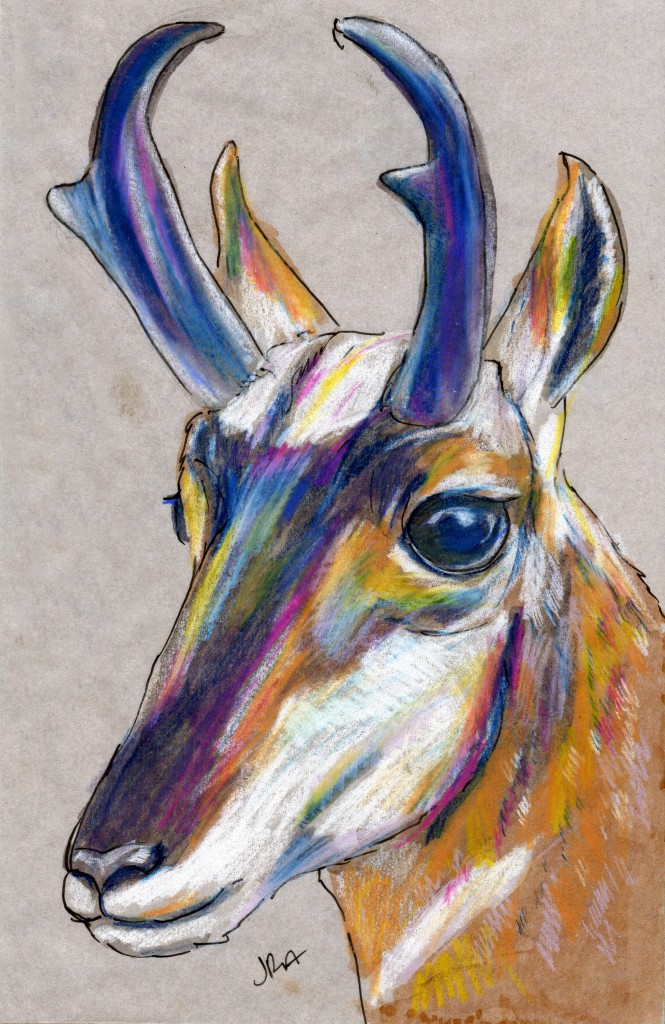Mammals of New Mexico Week: Pronghorn (Antilocapra americana)
The pronghorn is often called an antelope, but it’s not really an antelope. Another nickname for it is speed goat, but it’s not a goat, either. In fact, it’s in a class—or rather, family—of its own as the only member of the Antilocapridae.
There are antlers, like deer have, and there are horns, like cows and antelope have. Do you know the difference? Antlers are made of bone and are shed each year. Horns are made of compressed hair growing on a bony core and are permanent. Then there are what pronghorns have. Their horns are keratinous, like bovine horns, but they’re branched, like deer antlers, and pronghorns shed them each year like deer do. In fact, no bovines are known to shed their whole horns the way pronghorns do. This seems to me to be the main factor that’s keeping the pronghorn in its own separate family instead of among the bovines.
Before Europeans came to America, there were tens of millions of pronghorn here. Around the turn of the century, they were nearly killed off; now there are about a million left, it seems. The fastest land animal in the western hemisphere, pronghorn apparently evolved solely in North America, never migrating anywhere else. Ivan T. Sanderson has this to say:
Nothing at all like these animals is known anywhere; they are a solitary leftover from pre-glacial times, when their tribe was much more varied…In a matter of speaking, they are a sort of minor experiment in ‘antelopes,’ initiated by Nature and then dropped.
I take issue with the “minor” part. Seeing pronghorn on the flatlands of West Texas and southeastern New Mexico was one of the things I most looked forward to as a child when we’d drive from our house in Midland, TX, to see my grandparents in Tatum, NM. I have a vivid memory of seeing them jump over a barbed-wire fence, but everyone—including my dad and Ivan T.—says they can’t jump fences. It must have been a daydream.
This pronghorn, along with the rest of the New Mexico mammals this week, is dedicated to the memory of Maleta Scrivner, a dear family friend who loved dogs and desert animals.


Gorgeous drawing!
Pronghorn have always been one of my favorites. I’m with you about the “minor” crack…though I do wish we still had some of the crazy extinct antilocaprids around like the six-horned Hexameryx.
If they were still a diverse group I suppose we wouldn’t puzzle over them not quite fitting with bovids or cervids but accept them as the unique group that they are. It’s worth noting that while deer shed their entire antlers, pronghorn only shed the keratin sheath but retain the bony core.
Pronghorn do jump, though not as readily nor as high as deer. I’ve seen them jump washes. They have been seen to jump fences as high eight feet when chased (according to North Dakota Game and Fish) but are apparently less willing to do so if they aren’t being pursued. I suppose this reflects the fact that they are truly creatures of the open plains.
Some have suggested their astonishing speed is a left over adaptation to escape the extinct American “cheetah.” A romantic notion, although I don’t know if it’s true…I can see a benefit for being able to efficiently get between widely dispersed water sources or forage as quickly as possible.
As long as I’m running on and on myself, seems like I should put in a plug for Scott Carrier’s “Running After Antelope” book/radio story too!
Will this one go up for sale???
My dad says he has seen them go under a low spot in a fence at almost a dead run.
Neil: Thank you! And thanks for introducing me to the Hexameryx. Here’s a photo of a fossilized set of Hexameryx horn cores, and here’s an artist’s depiction of what they may have looked like.
The fence I remember seeing them jump was probably only four feet tall. I remember talking to my dad (chilejack who pops up here sometimes) about how wild animals can live inside barbed-wire fences, and whether the person who owns the land owns the pronghorns, and I could have just imagined them jumping the fence and created a vivid enough image in my head that it became a memory.
I suppose their speed was and is helpful in several ways. Chilejack, I think I’ve seen pictures or footage of them going under fences.
I’ve seen them jump six ‘ fences down around Magdalena
Saw lots yesterday up in the San Luis valley (by Walsenberg) – all sitting and looking around! Very cool.
They seem to play more with cows than deer though…
LAC